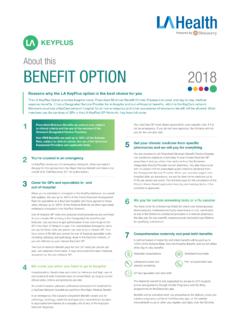Transcription of Public Health Classics Penicillin: from discovery to product
1 Public Health ClassicsThis section looks back to some ground-breaking contributions to Public Health , reproducing them in their originalform and adding a commentary on their significance from a modern-day perspective. To complement the theme ofthis month sBulletin, Sir Richard Sykes reviews the 1929 paper by Alexander Fleming on the antibacterial action ofcultures of a penicillium. The original paper is reproduced from theBritish Journal of Experimental : from discovery to productRichard Sykes1A bacteriology student reading the title of Fleming slandmark paper (1) today in an electronic CurrentContents list might well ignore the article. Antibioticuse is commonplace and isolating bacteria is relativelystraightforward on modern, selective media. But weneed to consider this paper in its 1929 context toappreciate its s succinct 10-point summary showsthe extent to which he had explored his originalfinding that colonies of staphylococci near a mouldcolony were degenerate.
2 His research coveredconditions for optimizing production of the newnatural product , penicillin, named following thenomenclature applied to other natural products, fromDigitalis. Fleming explored the spec-trum of activity of his novel compound usingtechniques that he devised to estimate its potency,bactericidal activity, interaction in the presence ofleukocytes, efficacy and toxicity in animals. Thisbroad evaluation of penicillin encompasses many ofthe key areas that would be used today in support ofan application to use a new antibiotic for the first timein man. Fleming particularly appreciated the lack oftoxicity and irritancy, evidenced by its applicationtopically in the eye and by intravenous injection assessed his own contribution to thediscovery of penicillin in his address to the Universityof Edinburgh in 1952 when he took Success as thetopic for his inaugural lecture as the newly electedRector (2).
3 He referred to the phenomenal success ofLouis Pasteur, attributing it to hard work, carefulobservation, clear thinking, enthusiasm, and a spot ofluck. He acknowledged the place that chance had hadin his own career, beginning with his choice ofSt Mary s Medical School because he liked swimmingand it had an active swimming club. His ownassessment of his role in the discovery of penicillinwas that he saw something unusual and appreciatedsomething of its importance and so began to work onit. He also found that the more he worked on it themore interesting it became. Fleming was fortunate inbeing free to work on his finding, without otherpressures, until he had reached the point where hecould no longer pursue the necessary chemical stepsto exploit his discovery fully. He stressed that it is thelone worker who often makes the first advance in asubject.
4 The details may be worked out later by a teambut team members need to work in concert and somay prevent discovery if chance observations cannotbe followed up because of other objectives orconstraints. He quoted from a friend, MervynGordon: No research is ever quite complete. It isthe glory of a good bit of work that it opens the wayfor still better and thus rapidly leads to its owneclipse (3).Fleming s 1929 paper paved the way to anenormous amount of future work, including an entireindustry that now makes antibiotics by the tonaround the globe. Fleming began by describing thecharacteristics of the mould and its growth undervarious temperature conditions, noting that it wasmost rapid at 20oC. He checked other moulds to seeif they had the same property but realized that hisstrain was unusual in that the broth filtrate hadinhibitory properties.
5 His colleague s original namingof the mould as most likeP. rubrum provedsubsequently to be incorrect andP. notatumwas thedesignation given by Raistrick and confirmed byThom in the USA. Fleming noted that penicillinactivity diminishes over time, and the labile nature ofthe new molecule was to prove a problem to othersduring the chemical scale-up of is acknowledged by contemporaries asa superb technician, and a glass blower of consider-able skill. The methods he used and the principles heapplied to testing his new agent are still in use today,so the 1929 paper laid important foundations for themodern science of antibacterial test for antibacterial activity, Fleming used asimple ditch, cut in an agar plate, which he filled with1 Chairman, GlaxoSmithKline plc; Rector, Imperial College of Science,Technology and Medicine, Exhibition Road, London SW7 2AX, England(fax: +41 207 594 5004).
6 Ref. #World Health Organization 2001 Bulletin of the World Health Organization, 2001,79(8)filtrate and agar. When the ditch had solidified hecross-streaked it with seven different organisms tosee which might be inhibited. The figure in the 1929paper shows clear inhibition of staphylococcus,pneumococcus, streptococccus, the gonococcusandCorynebacterium coliandHaemophilusstrains were not inhibited, both weredesignatedBacillusspecies at that time. This simpleexperiment gave an immediate impression of thespectrum of penicillin and is a forerunner of the typeof screening that is used today to get an earlyoverview of the extent of activity of a novelantimicrobial attempted some quantification of hisexperiment by measuring the extent of inhibition inmm for each organism and recorded the inhibitoryaction of doubling dilutions of his filtrates.
7 Thesemethods again were equivalent to today s MIC testsand disk diffusion methods, which have not beensuperseded because of their simplicity and theirability to convey valuable information quickly andcheaply whilst coping with the relatively highthroughput of organisms in busy hospital labora-tories. In addition, tests similar to Fleming sbactericidal tests are still conducted today to establishwhether new agents are bactericidal or Mary s laboratory under Sir Almroth Wrighthad a long tradition of immunological had been a friend of Ehrlich, and St Mary swas one of the first places that salvarsan was used inEngland to treat syphilis. Fleming had published onthis topic in 1911 and was technically expert in itsadministration. This background undoubtedly madehim very alert to the downside of toxic substances ininterfering with natural host defence processes.
8 Hispaper therefore showed that intravenous injection ofhis filtrate into rabbits in very large volume (20 ml)and also in mice had no toxic effects. Fleming wasfortunate that he had chosen for his experiments twospecies that tolerate penicillin well. He was perhapsalso fortunate that he chose to inject his filtrate andnot to feed it orally: the subsequent finding thatpenicillin could kill guinea-pigs if administered orallybecause of effects on caecal flora might haveprematurely ended interest in the new was not constrained by modernregulations on the use of novel agents and clearlyexperimented with his filtrates on patients orvolunteers. He describes irrigation of large infectedsurfaces in man and also of the human conjunctivaevery hour for a day without irritant effect. The useon skin surfaces may have been tried because ofFleming s First World War experience in France,when he was faced with gangrenous infections whichhe treated with antiseptics.
9 His publications of 1917and 1919 both relate to the dynamics of woundinfection. His experience with lysozyme also showedthat lytic effects could be achieved with naturalsubstances. Fleming was acutely aware that anti-septics did not always work beneficially in woundsbecause they had a damaging effect on leukocyteswhich he had observed could remove bacteria frompus. He clearly sought agents that did not have adeleterious effect, perhaps partly through theinfluence of Wright and following Ehrlich s principleof the need for a magic bullet to treat last part of Fleming s paper relates to useof penicillin to make a selective medium for isolationof the difficult to growBacillus again is a forerunner of the manyselective media that are available commercially of antibiotics, dyes, and antisepticagents is usual in order to select or enrich cultures ofstrains that otherwise are difficult to continued to work on his finding andto discuss it with others in the years following itspublication.
10 Coincidentally, in 1929, Howard Floreybegan to work on lysozyme and became interested innatural antibacterial substances. Together with ErnstChain, he used Fleming s and Raistrick s earliermethods of solvent extraction and succeeded inseparating need for medicines to treat infections inthe Second World War acted as a spur to unparalleledindustrial collaboration on both sides of the of the companies involved are major pharma-ceutical houses today, employing thousands ofpeople and contributing significantly to Health careeverywhere. In the following 60 years thousands ofnovel antibacterials have been described, some ofwhich have been developed to the status ofmedicines for human or animal itself founded a family of relatedmolecules that have contributed significantly to amassive reduction in infections in the last half of the20th century.















